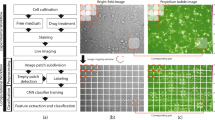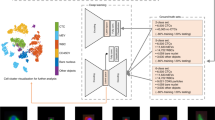Abstract
The classification of apoptotic and living cells is significant in drug screening and treating various diseases. Conventional supervised methods require a large amount of prelabelled data, which are often costly and consume immense human resources in the biological field. In this study, unsupervised deep learning algorithms were used to extract cell characteristics and classify cells. A model integrating a convolutional neural network and an autoencoder network was utilised to extract cell characteristics, and a hybrid clustering approach was employed to obtain cell feature clustering results. Experiments on both public and private datasets revealed that the proposed unsupervised strategy performs well in cell categorisation. For instance, in the public dataset, our method obtained a precision of 96.72% on only 1000 unlabelled cells. To the best of our knowledge, this is the first time unsupervised deep learning has been applied to distinguish apoptosis and live cells with high accuracy.




Similar content being viewed by others
Availability of data and materials
The datasets generated during and/or analysed during the current study are available from the corresponding author on reasonable request.
References
Kaczanowski, S.: Apoptosis: its origin, history, maintenance and the medical implications for cancer and aging. Phys. Biol. 13(3), 31001 (2016)
Ntuli, T.M.: Apoptosis and Medicine. IntechOpen, New York (2012)
Kerr, J.F., Wyllie, A.H., Currie, A.R.: Apoptosis: a basic biological phenomenon with wideranging implications in tissue kinetics. Br. J. Cancer 26(4), 239–257 (1972)
Horvitz, H.R.: Genetic Control of Programmed Cell Death in the Nematode Caenorhabditis Elegans. In: Mihich, E., Schimke, R.T. (eds.) Apoptosis, pp. 1–13. Springer, Boston (1994)
Fuchs, Y., Steller, H.: Live to die another way: modes of programmed cell death and the signals emanating from dying cells. Nat. Rev. Mol. Cell Bio. 16(6), 329–344 (2015)
Norbury, C.J., Hickson, I.D.: Cellular responses to DNA damage. Annu. Rev. Pharmacol. 41(1), 367–401 (2001)
Wong, R.S.: Apoptosis in cancer: from pathogenesis to treatment. J. Exp. Clin. Canc. Res. 30(1), 1–14 (2011)
Kerr, J.F.: History of the events leading to the formulation of the apoptosis concept. Toxicology 181, 471–474 (2002)
Willingham, M.C.: Cytochemical methods for the detection of apoptosis. J. Histochem. Cytochem. 47(9), 1101–1109 (1999)
Elmore, S.: Apoptosis: a review of programmed cell death. Toxicol. Pathol. 35(4), 495–516 (2007)
Ito, Y., Otsuki, Y.: Localization of apoptotic cells in the human epidermis by an in situ DNA nick end-labeling method using confocal reflectant laser microscopy. J. Histochem. Cytochem. 46(6), 783–786 (1998)
Purschke, M., Rubio, N., Held, K.D., Redmond, R.W.: Phototoxicity of Hoechst 33342 in time-lapse fluorescence microscopy. Photoch. Photobio. Sci. 9(12), 1634–1639 (2010)
Laissue, P.P., Alghamdi, R.A., Tomancak, P., Reynaud, E.G., Shroff, H.: Assessing phototoxicity in live fluorescence imaging. Nat. Methods 14(7), 657–661 (2017)
LeCun, Y., Bottou, L., Bengio, Y., Haffner, P.: Gradient-based learning applied to document recognition. Proc. IEEE 86(11), 2278–2324 (1998)
Krizhevsky, A., Sutskever, I., Hinton, G.E.: Imagenet classification with deep convolutional neural networks. Adv. Neural Inf. Process Syst. 25, 1097–1105 (2012)
Simonyan, K., Zisserman, A.: Very deep convolutional networks for large-scale image recognition. Preprint https://arxiv.org/abs/1409.1556 (2014)
Esteva, A., Robicquet, A., Ramsundar, B., Kuleshov, V., DePristo, M., Chou, K., Cui, C., Corrado, G., Thrun, S., Dean, J.: A guide to deep learning in healthcare. Nat. Med. 25(1), 24–29 (2019)
Kermany, D.S., Goldbaum, M., Cai, W., Valentim, C.C., Liang, H., Baxter, S.L., McKeown, A., Yang, G., Wu, X., Yan, F.: Identifying medical diagnoses and treatable diseases by image-based deep learning. Cell 172(5), 1122–1131 (2018)
Verduijn, J., Van der Meeren, L., Krysko, D.V., Skirtach, A.G.: Deep learning with digital holographic microscopy discriminates apoptosis and necroptosis. Cell Death Discov. 7(1), 1–10 (2021)
Ballard, D.H.: Modular learning in neural networks. Paper presented at the 6th AAAI, Seattle, WA, 279–284 July 1987 (1987)
Varamin, A.A., Abbasnejad, E., Shi, Q., Ranasinghe, D.C., Rezatofighi, H.: Deep auto-set: A deep auto-encoder-set network for activity recognition using wearables. In: Paper presented at proceedings of the 15th EAI International Conference on Mobile and Ubiquitous Systems: Computing, Networking and Services, New York, USA, 246–253 November 2018 (2018)
Jia, G., Lam, H., Liao, J., Wang, R.: Classification of electromyographic hand gesture signals using machine learning techniques. Neurocomputing 401, 236–248 (2020)
Rubio-Solis, A., Panoutsos, G., Beltran-Perez, C., Martinez-Hernandez, U.: A multilayer interval type-2 fuzzy extreme learning machine for the recognition of walking activities and gait events using wearable sensors. Neurocomputing 389, 42–55 (2020)
Hou, Y.J., Xie, Z.X., Zhou, C.C.: An unsupervised deep-learning method for fingerprint classification: the ccae network and the hybrid clustering strategy. Preprint https://arxiv.org/abs/2109.05526 (2021)
Baldi, P.: Autoencoders, unsupervised learning, and deep architectures. In: Paper presented at proceedings of the 2011 International Conference on Unsupervised and Transfer Learning workshop, Washington, USA, 37–50 July 2011 (2011)
Kingma, D.P., Welling, M.: Auto-encoding variational bayes. Preprint https://arxiv.org/abs/1312.6114 (2013)
Aytekin, C., Ni, X., Cricri, F., Aksu, E.: Clustering and unsupervised anomaly detection with I2 normalized deep auto-encoder representations. In: Paper Presented at 2018 International Joint Conference on Neural Networks (IJCNN), Rio de Janeiro, Brazil, 1–6 July 2018 (2018)
Schroff, F., Kalenichenko, D., Philbin, J.: Facenet: A unified embedding for face recognition and clustering. In: Paper Presented at Proceedings of the IEEE Conference on Computer Vision and Pattern Recognition, Boston, USA, 815–823 June 2015 (2015)
Zhou, C., Gu, Y., Fang, G., Lin, Z.: Automatic morphological classification of galaxies: convolutional autoencoder and bagging-based multiclustering model. Astron. J. 163(2), 86 (2022)
MacQueen, J.: Some methods for classification and analysis of multivariate observations. In: Paper Presented at Proceedings of the 5th Berkeley Symposium on Mathematical Statistics and Probability, Oakland, USA, 281–297 July 1966 (1967)
Murtagh, F.: A survey of recent advances in hierarchical clustering algorithms. Comput. J. 26(4), 354–359 (1983)
Zhang, T., Ramakrishnan, R., Livny, M.: BIRCH: an efficient data clustering method for very large databases. SIGMOD Rec. 25(2), 103–114 (1996)
Kingma, D.P., Adam, B.J.: A method for stochastic optimization. Preprint https://arxiv.org/abs/1412.6980 (2014)
Van der Maaten, L., Hinton, G.: Visualizing data using t-SNE. J. Mach. Learn. Res. 9(11), 2579–2605 (2008)
Hinton, G.E.: Training products of experts by minimizing contrastive divergence. Neural Comput. 14(8), 1771–1800 (2002)
He, K., Zhang, X., Ren, S., Sun, J.: Deep residual learning for image recognition. In: Paper Presented at 2016 IEEE Conference on Computer Vision and Pattern Recognition (CVPR), Las Vegas, USA, 770–778 June 2016 (2016)
Szegedy, C., Liu, W., Jia, Y., Sermanet, P., Reed, S., Anguelov, D., Erhan, D., Vanhoucke, V., Rabinovich, A.: Going deeper with convolutions. In: Paper Presented at 2015 IEEE Conference on Computer Vision and Pattern Recognition (CVPR), Boston, USA, 1–9 June 2015 (2015)
Funding
This work was supported by grants from the Key-Area Research and Development Program of Guangdong Province (Grant Number: 2022B0303040003) and the National Natural Science Foundation of China (NSFC) (Grant Numbers: 62135003 and 61875056).
Author information
Authors and Affiliations
Contributions
Z-Z designed and performed experiments, analysed data and wrote the paper. BN-S provided cell pictures. SQ-H, GC-W and CY-B find relevant information and provide ideas. TS-C designed the study and planned the experiments.
Corresponding author
Ethics declarations
Conflict of interest
The authors declare no competing financial interest.
Additional information
Publisher's Note
Springer Nature remains neutral with regard to jurisdictional claims in published maps and institutional affiliations.
Rights and permissions
Springer Nature or its licensor (e.g. a society or other partner) holds exclusive rights to this article under a publishing agreement with the author(s) or other rightsholder(s); author self-archiving of the accepted manuscript version of this article is solely governed by the terms of such publishing agreement and applicable law.
About this article
Cite this article
Zheng, Z., Sun, B., He, S. et al. Unsupervised deep learning of bright-field images for apoptotic cell classification. SIViP 17, 3657–3664 (2023). https://doi.org/10.1007/s11760-023-02592-1
Received:
Revised:
Accepted:
Published:
Issue Date:
DOI: https://doi.org/10.1007/s11760-023-02592-1




